The Roundup
What do these photos tell you about how cattle were rounded up?
An Early Wake Up Call
This photo shows cowboys like those who took part in roundups. They are sitting in their bedrolls. Bedrolls were blankets used like sleeping bags at night.
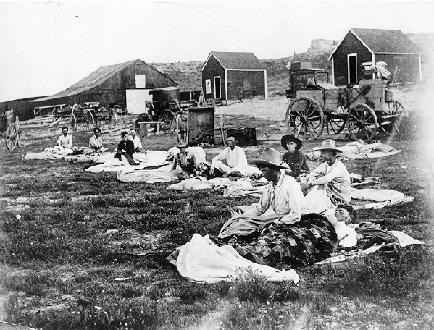
Photo: Colorado Historical Society
More About This Topic
During most of the year, cattle were left to graze on the open plains. Cowboys from different ranches came together each spring and fall to round up the cattle. They separated the cattle that belonged to the various ranches, branded the new calves, and drove steers to market. For several weeks during the roundups, cowboys slept and ate in the out-of-doors.
Their Own Words
"There were generally two roundups, one in the spring about May 10-15 when the grass started, and one in the fall, generally in September. Cattle were allowed to drift all winter and shift for themselves. Naturally they would drift south with the storms. In the spring some of them would be found as far south as the Arkansas river. . . . The spring roundup was mostly for the purpose of branding the calves. Cows dropped their calves mostly in April or May though they dropped some late in the fall. The calves would be caught and branded, then let loose to run with the cows until fall. . . ."
"The fall roundup in September was called the beef roundup. It was then that the beef steers would be cut out for market, the sucking calves taken from their mothers and put in a separate pasture, and the cows allowed to range for the winter. Steers were generally sold when they were three or four years old. They brought about $30.00 per head."
Source: Frank Loustalet (1934), CWA Interviews, Doc. 343/41, Colorado Historical Society.
Branding Range Cattle
The cowboys in this photo are rounding up and branding cattle. The man standing behind the cow is holding a branding iron.
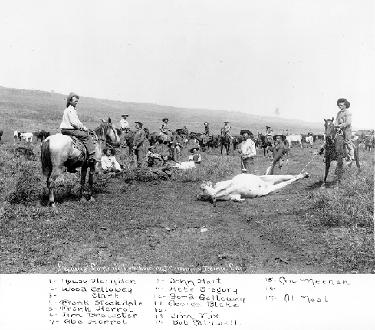
Photo: Colorado Historical Society
More About This Topic
At the roundups, the cowboys branded the young cattle born on the open plains that year. The brand was a mark burned onto the hide of each animal. Each ranch had its own brand so that everyone knew who owned each animal.
Their Own Words
"There were hundreds of head of cattle that roamed the prairies of open range in the early days. Everyone’s cattle roamed the range together, and it was an ordeal to sort them out, and could not have been accomplished if not for the brands on them."
Source: Ormal Humburg testimony in Roleta D. Teal, Kiowa County (Kiowa Co. Bicentennial Commission, 1976): 32-33.
A Chuck Wagon
This is a fully loaded mess wagon or chuck wagon. The photo shows the cowboys’ bedrolls piled on top of the wagon. The man behind the wagon is standing beside an iron stove on wheels.
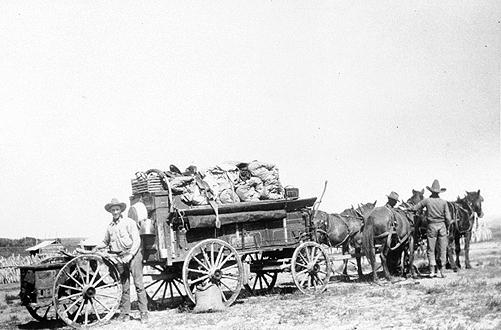
Photo: Colorado Historical Society
More About This Topic
The mess wagon or chuck wagon was part of every roundup. (In cowboy slang, the word “chuck” meant food.) The roundup cook drove and took care of the wagon. The man standing beside the stove in this photo probably was the cook. Most chuck wagons did not have a stove. Many cooks prepared meals over an open fire.
Their Own Words
"Very few people now living know what an old time Roundup was like. A cow outfit would consist of a mess wagon to carry out the beds and food, a cook, about eight riders (each rider had about four horses to ride -- a different horse for different kinds of work), a foreman, and a horse herder. The outfit would start to work about May 1st down in Kansas, east of the present state line. When all of the outfits got together there would be sometimes thirty or more wagons and 200 or more riders with five to eight hundred horses. "
Source: John P. Dickinson, "Life in Eastern Colorado," Colorado Magazine, 19 (1942): 193.
Eating During Round Up
This photo shows cowboys eating beside a chuck wagon. The cook prepared the food in pots over the open fire shown on the left of the photo.
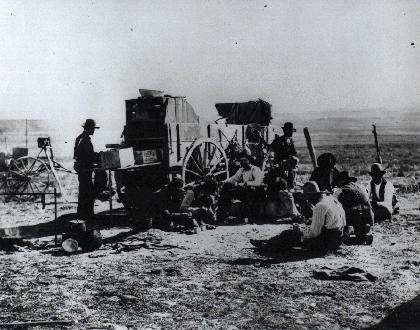
Photo: Colorado Historical Society
More About This Topic
The cowboys who rounded up cattle ate at chuck wagons like this one. This cook stored the food in the “chuck box” at the rear of the wagon. He cooked it over an open fire.
Their Own Words
"The chuck wagon had a box built on the back with compartments of all sizes built in so the cook’s supplies didn’t rattle around on the trip. The front dropped down to make a table. One side of the box was for storage for pots and cookers, flour and potatoes. The cook had a set of pot racks he set up over the campfire. A good cook could fix a complete meal over a campfire, including sourdough bread."
Source: J. E. “Shorty” Chronister testimony in Roleta D. Teal, Kiowa County (Kiowa Co. Bicentennial Commission, 1976): 97-98.
Eating a Late Dinner During Round Up
This photo shows cowboys eating dinner at night during a roundup.
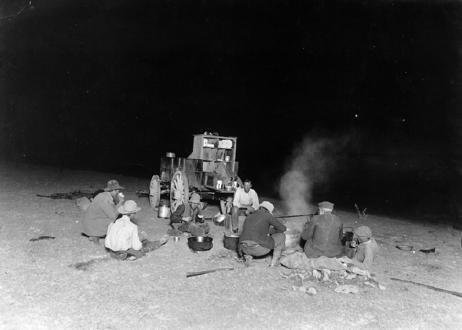
Photo: Denver Public Library, Western History Collection
More About This Topic
Cowboys spent long days rounding up cattle. The men in this photo did not stop for dinner until after dark.
Their Own Words
"Each outfit [during the roundups] consisted of a mess wagon, bed wagon, cook, about twelve men (these being cow hands and bosses) and each cowboy had from seven to eight horses. "
Source: Frank Tanberg, "Cowboy Life on the Open Range of Northeastern Colorado," Colorado Magazine, 12 (1935): 23.
North Park Horse Round Up (1888)
This photo shows horses in a corral. It was taken in 1888 during a horse round up in the North Park area of Colorado.
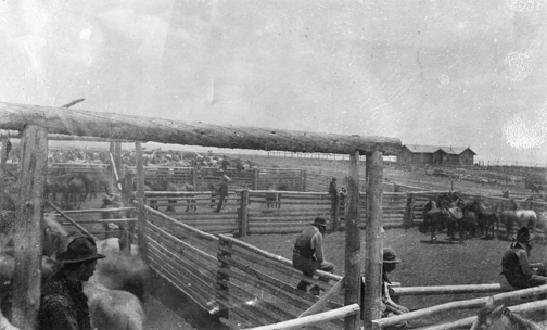
Photo: Denver Public Library, Western History Collection
More About This Topic
In some places in Colorado, cowboys rounded up horses instead of cattle. The horses in this photo were wild horses that lived on the open grassland of North Park. Cowboys like the ones sitting on these fences would break or tame the horses and train them to herd cattle.
Their Own Words
"Before the branding season started it was a job for every rancher to train his string of saddle horses to work with a rope, and to hold a cow. When branding calves it was the responsibility of the roper to bring the calf as near to the men who were doing the branding as possible, throw the calf and call out the brand to the men who held the calf down. These men released the rope immediately, so that the roper could get another calf."
"This whole responsibility of placing the proper brand on a calf rested with the roper. It was he who must read the brand on the mother of every calf he roped. Such work required skilled men with a rope and also men who could quickly and accurately read brands. It was the practice to round-up the cattle in the morning and brand all unbranded stock in the herd in the afternoon."
Source: Frank Hodgson, 1934, CWA Interview Doc. 33/343, Colorado Historical Society.

